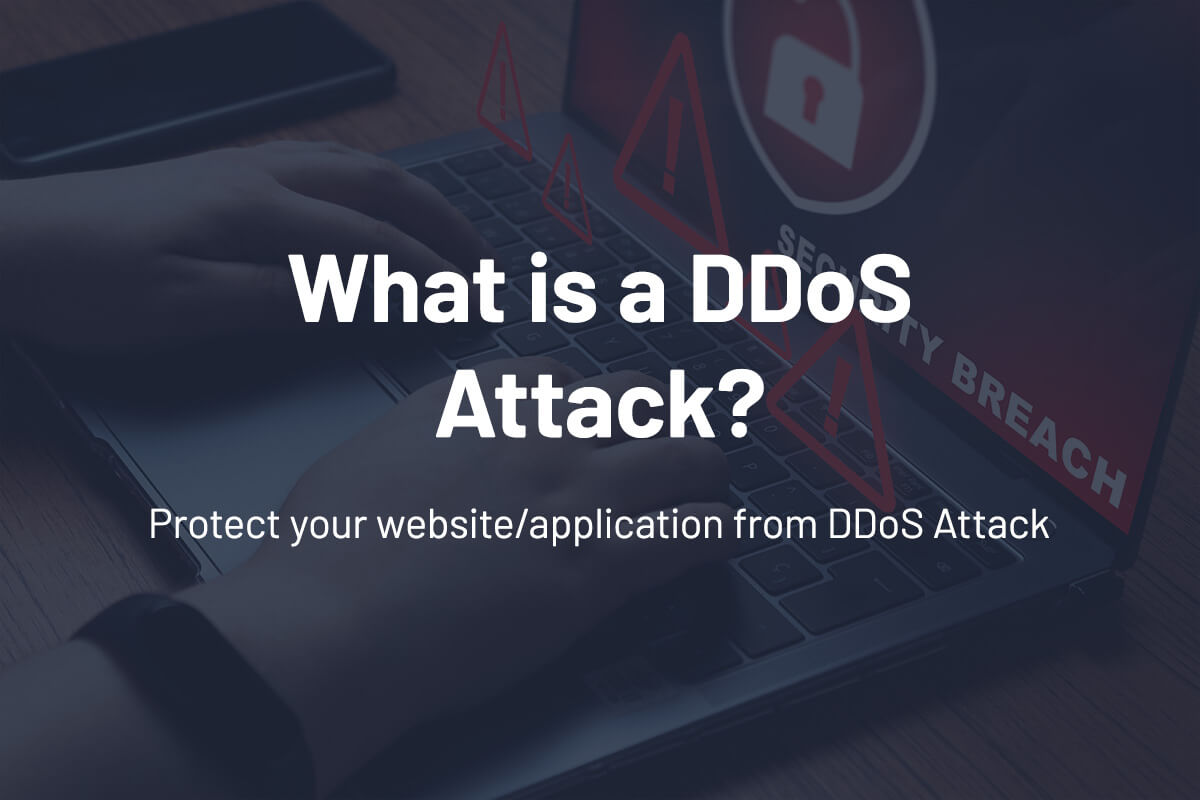
What is a DDoS Attack? Protect your website from DDoS Attack | Hyrrokkin
What is a DDoS Attack?
According to a 2023 report, DDoS attacks have increased by 200% over the past five years, affecting businesses of all sizes. The Distributed Denial of Service (DDoS) attack is a malicious attempt to disrupt the normal traffic flow of a targeted server, service, or network. Imagine a road to a city (the server) becoming overwhelmed with traffic (data requests), causing a massive traffic jam and preventing regular traffic from reaching the city. This is done by inundating the target, or its surrounding infrastructure, with a colossal amount of Internet traffic. The unique aspect of a DDoS attack is its use of multiple compromised computer systems as sources of attack traffic, which can include both computers and other networked resources such as Internet of Things (IoT) devices. The threat of Distributed Denial of Service (DDoS) attacks looms large in the digital world. To illustrate, consider the 2016 attack on Dyn, a major DNS provider. This attack, leveraging a multitude of compromised IoT devices, disrupted access to major sites like Twitter, Netflix, and CNN, showcasing the devastating potential of DDoS attacks. It’s a stark reminder that these attacks are more than just a disruption; they can be pivotal in impacting access to critical online services. A DDoS attack, at its core, is a malicious attempt to flood a targeted server, service, or network with overwhelming Internet traffic, utilizing multiple compromised devices.
Why Does Someone Use a DDoS Attack against you?
Understanding the motivations behind DDoS attacks can be as critical as understanding the attacks themselves:
- Disruption of Service: Primarily, DDoS attacks aim to make a website or service unavailable to its users, damaging the victim’s reputation and reliability.
- Extortion: Sometimes, attackers demand payment in return for ceasing the attack.
- Diversion: These attacks can act as a smokescreen for other malicious activities, such as data theft or security breaches.
- Activism or Revenge: Political motivations, activism, or personal grudges can fuel such attacks.
- Business Rivalry: Competitors might use DDoS attacks to disrupt each other’s business operations.
Protecting from DDoS Attacks Without WAF (Web Application Firewall)
- Overprovision Bandwidth: While it doesn’t prevent attacks, having excess bandwidth can help manage sudden traffic surges. This is like having wider roads to handle more traffic and reduce congestion.
- Robust Network Architecture: Implementing a dispersed server set up in various locations can distribute the load and reduce risks. Think of this as building multiple roads to the city, so if one is congested, others can handle the traffic.
- ISP or Hosting Provider Support: These providers may offer solutions to reroute traffic or bolster resources during an attack.
- Rate Limiting: Restrict the number of requests a server can accept in a given timeframe to mitigate potential attacks. This is akin to having a toll booth on the road, limiting the number of cars that can pass through per minute.
- DDoS Response Plan: A predefined response plan enables swift, structured action upon detection of an attack.
Protecting a WordPress Website from DDoS Attack
WordPress, as one of the most popular content management systems, is frequently targeted by Distributed Denial of Service (DDoS) attacks. These attacks aim to overwhelm a website with traffic, rendering it inaccessible. However, there are several effective strategies to mitigate these risks and strengthen the security of a WordPress site. In this article, we will discuss the best practices for protecting a WordPress website from DDoS attacks.
- Regular Updates: Regular updates are crucial in maintaining the security of a WordPress site. Updates often include patches for security vulnerabilities that could be exploited in DDoS attacks. It’s important to keep the core WordPress software, along with any themes and plugins, up to date. Automated update features in WordPress can help ensure that you’re running the latest versions with the latest security fixes.
- Quality Hosting Provider: The choice of hosting provider plays a significant role in the security of a WordPress website. Opt for a hosting provider known for robust security measures and specific capabilities to mitigate DDoS attacks. These providers often offer features like network-level filtering and traffic analysis, which can be crucial in detecting and preventing DDoS attacks.
- Security Plugins: Security plugins like Wordfence or Sucuri act as an additional layer of defense for WordPress sites. These plugins function like security checkpoints, inspecting incoming data packets for malicious activity. They can block harmful traffic, scan for malware, and offer firewall capabilities to enhance website security. Regularly updating these plugins is also essential to ensure they protect against the latest threats.
- Disable XML-RPC: XML-RPC is a feature in WordPress that enables data transmission, like remote publishing from a mobile device. However, it can also be a common avenue for DDoS attacks. If you’re not using features that require XML-RPC, it’s a good practice to disable it. This can be done either through a plugin or by editing the WordPress configuration files.
- Limit Login Attempts: Brute force attacks, where attackers try multiple login combinations to gain access to your site, can evolve into a form of DDoS attack. To prevent this, limit the number of login attempts from a single IP address. This not only thwarts brute force attempts but also reduces the risk of your login page being used as a tool in DDoS attacks. Plugins are available in WordPress to easily implement this security measure.
By implementing these strategies, WordPress site owners can significantly enhance their website’s resilience against DDoS threats. If you need to do a manual security review, then feel free to avail our complimentary WordPress website security scan services.
Protecting a Laravel Application from DDoS Attack
Laravel, a popular PHP framework, provides a range of features to help safeguard applications against such threats. In this article, we will explore key strategies to protect a Laravel application from DDoS attacks, focusing on aspects like throttling, built-in security measures, the use of trusted packages, database security, and effective monitoring and logging.
- Use Throttling: One of the primary defences against DDoS attacks is to control the volume of user requests to the server. Laravel’s rate-limiting capabilities offer an effective way to implement throttling. This feature allows developers to specify the maximum number of requests a user can make in a given period, thus preventing overuse of resources. By setting up these limits, Laravel applications can reduce the impact of high traffic volumes, typical in DDoS attacks.
- Leverage Built-in Security: Laravel comes with several built-in security mechanisms that are essential in fortifying your application. One such feature is Cross-Site Request Forgery (CSRF) protection, which ensures that every POST request is accompanied by a valid token, thereby preventing unauthorized actions. Additionally, Laravel’s secure authentication and authorization systems, XSS protection, and SQL injection prevention mechanisms play a crucial role in securing the application.
- Trusted Packages: While Laravel offers extensive functionality out-of-the-box, developers often rely on third-party packages to extend these capabilities. It’s crucial to ensure that these packages are reliable, secure, and well-maintained. Always opt for packages with a good track record, regular updates, and a strong community backing. Keeping these packages up to date is also vital to patch any known vulnerabilities.
- Database Security: The database is a critical component of any web application, and securing it is paramount in DDoS protection strategies. It involves not only safeguarding the data but also managing the connections and queries to prevent overload. Implementing connection limits, using efficient queries, and monitoring database performance can help in mitigating DDoS risks. Additionally, regular backups and encryption of sensitive data add an extra layer of security.
- Monitoring and Logging: Detecting a DDoS attack early is key to mitigating its impact. Laravel’s logging and monitoring tools enable developers to keep a close watch on traffic patterns and server performance. By analyzing logs, one can identify abnormal traffic spikes or unusual request patterns indicative of a DDoS attack. Integrating real-time monitoring solutions can provide alerts and enable quick response to potential threats.
Protecting a Laravel application from DDoS attacks requires a multifaceted approach. If you need to check your application vulnerabilities and to maintain good code integrity then feel free to explore ourVAPT services.
Protecting a NodeJS Application from DDoS Attack
Node.js, renowned for its efficiency and scalability in building web applications, is not immune to the threats of Distributed Denial of Service (DDoS) attacks. Such attacks can severely disrupt service availability and compromise application security. In this article, we delve into key strategies for safeguarding Node.js applications against DDoS attacks, covering rate limiting, secure HTTP headers, body parsing, the use of reverse proxies, and the importance of updating dependencies.
- Rate Limiting: Rate limiting is a critical defence mechanism against DDoS attacks, which often involve flooding a server with excessive requests. For Node.js applications, especially those using the Express framework, the express-rate-limit module provides a simple yet effective solution. This module allows developers to control the number of requests a user can make within a specified timeframe, thus preventing a single user from overwhelming the server.
- Secure HTTP Headers: Securing HTTP headers is an important aspect of protecting web applications. The Helmet module in Node.js is a collection of middleware functions that set various HTTP headers to secure the application. By default, Helmet includes measures such as CSP (Content Security Policy), X-Frame-Options, and X-XSS-Protection, which help protect against common vulnerabilities like cross-site scripting and clickjacking.
- Body Parsing: To prevent attacks that involve sending large payloads to destabilize the server, it’s essential to regulate the size of the request body. Node.js applications can achieve this by configuring body-parsing middleware, such as body-parser, to limit the size of incoming request bodies. This approach is effective in mitigating large-payload attacks, ensuring that the server does not process requests with excessively large bodies.
- Use a Reverse Proxy: Implementing a reverse proxy is a strategic method to add an additional layer of security and control. Nginx, a popular choice for a reverse proxy, can handle and distribute incoming traffic to your Node.js application, acting as a shield against direct attacks. Moreover, Nginx can manage SSL termination, load balancing, and caching, further enhancing the application’s resilience against DDoS threats.
- Update Dependencies: Keeping Node.js and its dependencies up to date is vital for security. Developers must regularly update their environment and dependencies to patch known vulnerabilities. Automated tools can help in identifying outdated packages or versions, ensuring that the application runs on secure and stable versions of all components.
By adopting these strategies, developers can significantly enhance the security and robustness of their Node.js applications. If you need to evaluate your application security score, then feel free to explore our VAPT services.
The ever-evolving nature of DDoS attacks necessitates a proactive and comprehensive approach to digital security. Whether you manage a personal blog or a large-scale online service, understanding and implementing protective measures is imperative. The rise in these attacks underscores a crucial aspect of our digital era: the need for vigilance and resilience in the face of cyber threats. Reflecting on these incidents, one must ponder: how prepared are we, individually and collectively, to withstand and counter these digital onslaughts? The answer lies in our commitment to adopting robust security practices and fostering a culture of cybersecurity awareness.






